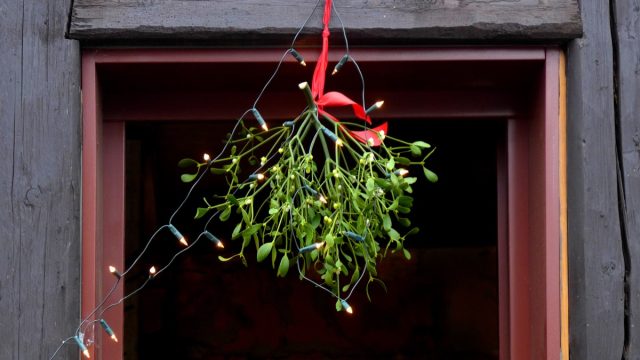This Is the History of Why We Hang a Mistletoe at Christmas

Did you know that mistletoe, one of the most romantic symbols of Christmas, is actually a type of parasite? That’s right. It saps much of its daily nutrients from the bark of the host trees on which it lives, causing abnormal growths known as “witches brooms” that deform the host’s branches and compromise its reproductive health. Not the most amorous of tales, that’s for sure. Yet, there’s good reason as to why we hang mistletoe at Christmas, and it has to do with both science and some very durable folklore, spanning thousands of years and multiple cultures.
While the bare scientific facts of mistletoe may make your skin crawl, they’re essential to truly understanding the plant. As you might have heard, mistletoe is poisonous, and when birds eat its berries, they tend to quickly excrete the sticky seed, which is likely to land on the branch of the tree on which they next sit. The seed then sticks itself to the tree, potentially allowing it to sprout the following year.
Actually, the name “mistletoe” itself sheds light on the plant’s physiology: When you break down the original term—mistiltan—you are left with two words, mistel, which means “dung,” and tan, which translates to “twig,” according to The Washington Post.
To look at mistletoe more symbolically, Rob Dunn of Smithsonian magazine notes: “Mistletoe is a measure of how many of the fruits in our daily lives, be they literal or figurative, depend on other species. We depend on the mistletoe for tradition. And it depends on its tree and its bird, just as we depend on thousands of species ourselves … our crops, our Christmas trees, and so many more.”
Sure, bird feces and sticky seeds don’t sound like components of a classic romance, but a mythological view casts a different light on the tenacious and misunderstood plant. Mistletoe’s association with vitality and good health is at least as old as the ancient Greeks, who regarded it as something of a panacea, according to History.com. Later, the ancient Roman naturalist Pliny the Elder described its efficacy in treating ulcers, epilepsy, and exposure to certain poisons.
In addition to its healing properties, mistletoe was used as an aid for reproduction, specifically by the Celtic Druids of the first century A.D. They considered it to be a symbol of vivacity and would administer the plant to both animals and humans to improve fertility.
One of the central stories concerning mistletoe, however—and that which seems to most directly connect to our modern understanding of the plant’s romantic significance—stems from Norse mythology. According to the folklore, the god Baldur, grandson of Thor, dreamt of his own death. Believing the dream to be a prophecy, Baldur’s mother, Frigg, went to great lengths to prevent it from coming true—making all plants and animals take an oath that no harm would be done to her son. But Frigg failed to secure an oath from mistletoe, and without delay, the trickster god Loki fashioned an arrow from the plant, which he then used to slay Baldur. Then, after the fallen god was mourned by his people, Baldur was resurrected, inspiring Frigg to declare mistletoe a symbol of love and make a vow that she would kiss all of those who passed beneath it.
Though it’s unclear how mistletoe began being linked to Christmas specifically, farmer Brian Barth of Smithosonian posits that “it makes sense that mistletoe, with its evergreen foliage and attractive red berries, would be brought indoors as decoration during the barren winter months, just as people do with fir boughs and holly branches.”
So if you do happen to walk under some mistletoe this holiday season, know that this isn’t just another novelty, but a very old ritual indeed!